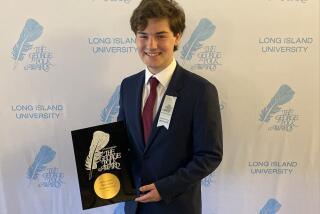Brains for Sale
IRVINE — When Dr. Gary Lynch talks, Wall Street listens.
The engaging, world-renowned UC Irvine neuroscientist told reporters at a recent Washington science convention that European studies suggest his experimental drug Ampalex enhances memory in healthy people. He noted government plans to test it in Alzheimer’s patients next year.
Over the next two days, shares of Cortex Pharmaceuticals Inc., whose future rides on the Alzheimer’s trials, more than doubled in price to $6.32.
All is not well, however, between the scientist and the sputtering little Irvine company he started with two UCI colleagues a decade ago.
Last summer, Lynch butted heads with Cortex’s chief executive Vincent F. Simmon when he refused to fund a fourth European study of the drug. “We can’t answer every scientific question in this area, when finances are limited,” asserts Simmon.
Lynch was incensed. The prolific brain researcher, who has survived over the years in the dog-eat-dog world of neuroscience, had not yet achieved that scientist’s intuitive sense of completion on the drug project.
“In science, you show the effect, and then you show it again, and then you show it again. The bigger the claim, the more potent the evidence,” he says.
“Wall Street doesn’t care.”
In a young industry of biotechnology, where few companies have managed to enter adolescence, Cortex’s childhood has been particularly difficult. It could easily have perished, multiple times, as the worlds of science, government, academia and business that created it clashed as much as they collaborated.
Indeed, Cortex’s highs and lows expose the weaknesses in the peculiarly American way of bringing biological breakthroughs to the marketplace.
Of course, the industry now boasts 1,300 companies, and even a few notable successes, such as Amgen and Genentech. But experts say Cortex typifies the vast majority of companies that once promised to unleash medical miracles on humanity, but have yet to sell a single product.
Like many, Cortex emerged in a mingling of subcultures that exemplified the 1980s’ go-go days: top-notch researchers hoping to cash in on their discoveries; Reagan-era lawmakers willing to relax laws to oblige them; Wall Street financiers seeking a quick buck; and academic administrators ill-prepared for the onslaught.
“You see a few scientists make a lot of money, then more want to make money like the few and a lot try. You may lose something in the process,” says Rebecca Eisenberg, a University of Michigan law professor who specializes in biotechnology patents.
“Money is a powerful motivator,” she said.
But Cortex, which employs 19 in its Irvine offices, lacked the instinct for what would sell, a solid business plan and steady leadership by top executives and board members willing to keep it all on track.
*
The company has posted accumulated losses of $26 million, while trying to develop a treatment for Alzheimer’s disease.
“This should have been one of the biggest success stories of the country,” says Jay Glass, of Laguna Beach, a former venture-capitalist. “I don’t know how they managed to fritter it away.”
More broadly, say experts, Cortex reflects the faulty but persistent American notion that good inventions find a market, or, in words attributed to Ralph Waldo Emerson: “If a man can make a better mousetrap, the world will make a beaten path to his door.”
Rather, it’s a nose for what people might buy that generally distinguishes innovations that can change the world, says David Lux, a historian, at Bryant College, in Smithfield, R.I.
Lux notes, for instance, that Thomas Edison first costed out what people would be willing to pay for an alternative to gas lighting before he invented the lightbulb.
Lynch is just the opposite.
He can’t be bothered by the daily management of minutiae that marks a successful business. Unlike many researchers who forsook academia to start their own biotech outfits, he kept his full-time job as a UCI professor.
He exemplifies the old myth of the wild-eyed, maverick scientist who disappears into his laboratory, the hopes of humanity resting on his shoulders, only to emerge months later with findings that rock the world.
*
He’s written or co-written more than 400 scientific articles, a few books, and gets credit for groundbreaking ideas on the biochemistry of human memory in the hoary halls of neuroscience.
“Gary tends to be ahead of his time,” says a government source familiar with his history of research successes. “The joke is, every new piece of data he gets, he puts together a new theory. But he’s brilliant.”
Interviewed a few weeks ago at his makeshift office in a trailer outside his UCI lab, Lynch, 53, was relaxing with a beer after returning from the Society of Neuroscience’s annual convention in Washington.
Hanging up the phone after a brief chat with the prominent female scientist he lives with, Lynch bursts out, “The convention. The convention. A madhouse!”
The society had seen fit to showcase research by Lynch and others that suggests the family of ‘ampakine’ drugs he invented, including Ampalex, may improve memory. No matter that ABC last year had featured ampakine-injected rats exhibiting better recall than drug-free peers in the New York lab of one of his collaborators, or that, earlier this year, Cortex had issued little-noticed news releases about key findings.
Lynch is a media event. His pronouncements made front-page news.
At the convention, as elsewhere, the company remained a sideshow. At the news conference, starring Lynch, where the society wanted to keep up appearances of unsullied science, the company’s public relations man, Peter Steinerman, got shown the door.
Simmon, Cortex’s chief executive, who entered the room with Steinerman, got the message and departed too. “I wasn’t permitted to be where [Lynch] was,” says Simmon.
Only Gary Rogers, a medicinal chemist who’d worked with his wife developing ampakine compounds for Lynch before becoming Cortex’s vice president of pharmaceutical discovery, talked his way in.
“[Lynch’s] involvement with the company does oscillate,” Rogers says.
“It depends on what else he has occupying his attentions. You might view it as a child-parent relationship. We, the company, as the children, when the parents ignore them, feel neglected.”
*
Aside from a desire to see his ideas put to use, Lynch freely admits that personal greed drove him to start Cortex in 1987.
The former blue-collar boy from Connecticut, raised by a divorced mom struggling to make ends meet, says, “I wanted to have enough money coming in so that if I got fed up with UCI, I could walk out the door. I didn’t want to have to depend on this salary.”
The country, at the time, welcomed such ambitions.
The nation that launched the A bomb, put a man on the moon and spent massively on basic research, had lured so many bright young Americans into science that the nation couldn’t digest all their discoveries.
Academic fiefdoms arose, led by researchers the likes of Lynch, absorbing legions of graduate students and post-docs, battling for government grants.
As competition for funding intensified, scientists on limited salaries worried about their retirement. Says one of Lynch’s UCI colleagues, “You can wear the hair shirt when you’re a functioning academic, but you retire at some point. Monks get to stay with the church; we don’t.”
Meanwhile, legal changes in the 1980s encouraged universities doing government-funded research to patent and license inventions. They also allowed patents based on life forms, and they gave investors favorable tax treatment.
Federal funding flowed into biomedical research, venture capital poured into offshoot enterprises, and economic developers counted new jobs.
*
Lynch and Cortex’s co-founders--his longtime friend, Carl Cotman, and Ralph Bradshaw, all nationally known brain researchers--pooled their smarts into an effort to develop diagnostic product and drugs to help victims of Alzheimer’s disease.
In hindsight, Lynch says they all had different ideas about how to accomplish that and struck out in their numerous attempts to attract investment from big-name venture capitalists.
Cotman, a Cortex board member, and Bradshaw, who left the company several years ago, couldn’t be reached for comment.
The trio fell into the hands of a New York investment banker, Kevin Kimberlin, then of D.H. Blair & Co.
This pinstriped, tousle-haired Harvard MBA, always looking for a phone, was the first “Wall-Street-type” guy Lynch said he had encountered. Lynch was impressed with Kimberlin’s directness about making money.
Cortex’s first president, Kimberlin secured office space, assembled a board of directors, hired executives, and carried a New York Times magazine cover story on Lynch around like a bible, the scientist recalls.
Thinly financed from the outset, Cortex got a tiny $2.5-million investment of venture capital from Blair in 1988, raised a paltry $6.6 million in a public offering the following year.
Without Blair, Cortex would never have gotten off the ground. But the company’s involvement with the firm hurt its ability to attract mainstream venture capitalists because Blair is known for making modest investments in fledgling biotechs and then quickly taking them public, say venture experts.
Without the patient guidance from longtime investors, Cortex meandered like a lost child. The company, taking the scientists’ findings that Alzheimer’s patients often begin to lose their ability to smell in the early stages of disease, initially planned to peddle a smell test to diagnose patients.
Trouble was, as typical academics, they lacked what private industry requires: a patent.
“I had published so much stuff on this that it was difficult to patent,” says Lynch, who doesn’t know to this day what happened to that product idea.
*
Cortex lurched ahead, lacking a skilled entrepreneur who might have closed the gap in business savvy. It suffered through five full-time or interim top executives between Kimberlin and Simmon, who joined Cortex last May.
Glass, the venture capitalist who invested a modest $500,000 in Cortex, stepped in to keep things together in 1991 when one chief executive abruptly resigned.
“It was the worst year of my life,” moans Glass, now retired.
Unlike his predecessors, Glass, a neuroscientist, understood the science. He honed its research pursuits. He made links with major investors who eventually gave millions.
He even lined up a deal in 1992 to license key technology for developing treatments for stroke victims to Alkermes, a Massachusetts company. The deal was aimed at generating millions of dollars for Cortex--a strategy of leasing out the family jewels that’s often used by struggling biotechnology companies to keep their doors open.
Lynch, who’d developed the technology, was “enraged,” says a former insider, adding, “The company was broke, needed cash, and when it’s survival is at a stake you sell your wife’s engagement ring to buy food.”
Like most such deals, say venture experts, the one with Alkermes unraveled. It ended in a legal settlement over drug development rights last fall that included Cortex’s buyback of the technology. In the meantime, says Lynch, competitors have stolen ahead of Cortex in the race to commercialize the concept.
*
Glass maintains the Alkermes deal kept Cortex alive. More important, he listened to Lynch’s frustrations about failing to interest prior top Cortex executives in ampakines--the invention that accidentally became what is now its best hope.
It’s hardly surprising that Lynch’s pleas for backing to develop ampakines had fallen on deaf ears at Cortex.
Though he’s scientific advisor to the company, and has even served two brief terms as a board member, Lynch has little patience for business management. He wouldn’t attend the traditional dinner meetings of board members before their regular board meetings--and still marvels at how much corporate America seems to yammer away time on the phone.
What’s more, Lynch admits he was distracted by an all-out intellectual battle over the way memory is formed and maintained. In article after article in scientific journals, he and his collaborators fought with some of the best minds in his field.
In desperation, Lynch sought funding for ampakines from one of his long-standing meal tickets--the U.S. Air Force. He’d been working on a basic research grant for studying learning in the brain stem--with possible applications for improving training of U.S. troops--and persuaded the agency to give him $75,000 to pay Rogers to develop ampakines.
Glass, sensing that Lynch and his collaborators on ampakines might take their marbles elsewhere, turned his efforts to licensing the invention that became what is now the company’s best hope.
Licensing ampakines--a deal that would normally take a month in the business world--consumed more than a year, says Glass, as he worked to resolve conflicting priorities of Lynch, his collaborators and university officials.
An interim executive, Glass gratefully turned over the reins to Alan Steigrod, an executive hired in 1993. Glass briefly remained a board member, but resigned in frustration when, as the board’s audit committee chairman, he couldn’t get regular financial statements out of the company.
Steigrod, a seasoned corporate manager, pushed forward with the ampakines.
But a scientist he isn’t. He got caught in battles between Cotman, who wanted funding for Alzheimer’s research, Lynch for ampakines, and Rogers for discovery of new ampakine-based drugs. “It was Carl pulling against Lynch, Lynch pulling against Rogers,” says a source. “You can’t have it all with a company that had no money.”
*
Steigrod quit last fall.
“I resigned because it wasn’t fun anymore,” he says, but declined to elaborate.
By December last year, Lynch, too, had left the board.
“I got off the board because the university wanted me off,” says Lynch. Cortex had increased investments in basic research at UCI, and officials worried that Lynch, who owns 2% of Cortex’s stock, might appear to be enriching himself by directing the research investment to his lab, he says.
One of Lynch’s UCI colleagues notes that the university seems schizophrenic in its support of such collaborations between scientific investigators and industry. It happily pockets a much bigger chunk of licensing revenue than the discoverers do; but once the research dollars flowing in from a company get sizable, it gets nervous about the appearance of conflicts, says the source.
Off the board, Lynch now says Cortex seems like someone else’s company. It’s working to find itself, pressing forward with plans to test Ampalex not only as a treatment for Alzheimer’s, but also for schizophrenia.
But Lynch casts a big shadow.
Rogers, who now gives Cortex’s presentations to Wall Street, says investors frequently ask whether Lynch is still involved: “It’s very obvious that they’re concerned that he still is.”
Lynch professes he’ll continue to hand off his inventions to Cortex, as ever.
But the veteran investigator has turned his attentions to evolving a theory of either how the brain in general works, or how it ages. And he, better than anyone, knows that at age 53, he needs to move quickly to keep ahead of the effects of aging.
Already, in lectures before hundreds of UCI students, he’s losing the flexibility to hold forth on one idea, leap through multiple tangents, then, retaining it all, swing back for the big wrap-up.
“It’s a sort of trapeze act. All of a sudden you’re there, and you don’t remember where you started,” he says.
He imagines lights dimming in chunks of his gray matter.
“I can almost see this thing, slipping away into the darkness.”
(BEGIN TEXT OF INFOBOX / INFOGRAPHIC)
Fond Memory
Two weeks ago, Cortex Pharmaceuticals stock bounded out of the doldrums on news that its new drug id effective for memory restoration. A look at the company and its November stock performance: Cortex Pharmaceuticals, at a Glance
Headquarters: Irvine
Chairman: Dr. Harvey Sadow
President/ CEO: Vincent F. Simmon
Business: Pharmaceuticals; has developed an experimental drug to treat memory loss in age-related disorders such as Alzheimer’s disease.
Employees: 19
Exchange: Nasdaq
52-week high: $8.75 on Feb. 16, 1996
52-week low: $2.38 on Dec. 18, 1995
Daily Closing Stock Prices:
Friday’s close: $5.13 (Nov. 29)
* Sources: Bloomberg Business News; Cortex Pharmaceuticals
* Researched by JANICE L. JONES / Los Angeles Times






